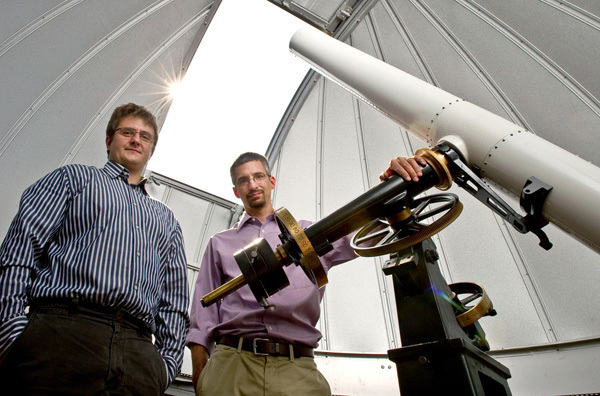
A team of researchers from several universities and institutions including Chris Howk and Nicolas Lehner at Notre Dame has demonstrated how galaxies continue to form stars by recycling vast amounts of hydrogen gas and heavy elements across billions of years. The researchers also identified large masses of previously undetected material surrounding galaxies, and described the large-scale flows of this gas. The results were published in three papers in the Nov. 18 edition of Science magazine. The leaders of the three studies are Nicolas Lehner of Notre Dame, Todd Tripp of the University of Massachusetts at Amherst, and Jason Tumlinson of the Space Telescope Science Institute in Baltimore.
The researchers used the Cosmic Origins Spectrograph (COS) on the Hubble Space Telescope to detect the mass in the halos of the Milky Way and more than 40 other galaxies. The process uses absorption lines in the high-resolution spectra of background quasars or stars to detect the gases in the clouds, which are invisible to other kinds of imaging. Data from the Large Binocular Telescope in Arizona, Keck in Hawaii and the Magellan Telescope in Chile were also key to the studies by measuring the properties of the galaxies.
“We show that not only there is enough mass in the gas flows in halos of galaxies to sustain star formation over billions of years, but also the mass in the hot halos of star-forming galaxies is phenomenal—as large as the mass of gas in the disk of a galaxy!” says Lehner.
Clouds of ionized hydrogen within 20,000 light years of the Milky Way disk contain enough material to make 100 million suns. About one solar mass of that gas falls into the Milky Way every year, comparable to the rate at which our galaxy makes stars. The cycle could continue for several billion years.
In more distant galaxies, the team found element-rich halos around star-forming galaxies, including surprising levels of heavy elements up to 450,000 light years beyond the visible portion of the galactic disks. COS measured 10 million solar masses of oxygen in a galaxy’s halo, which corresponds to about 1 billion solar masses of gas.
Some of the galaxies that form stars at a very rapid rate, perhaps a hundred solar masses per year, can drive million-degree Fahrenheit gas very far out into intergalactic space at speeds of up to 2 million miles per hour. This is fast enough for the gas to escape forever and never refuel the parent galaxy. “We have observed hot gas in the process of moving out of a galaxy and into intergalactic space, ” Tripp says.
“Our results confirm a theoretical suspicion that galaxies expel and can recycle their gas, but they also present a fresh challenge to theoretical models to understand these gas flows and integrate them with the overall picture of galaxy formation,” Tumlinson says.
Links to additional information and images: